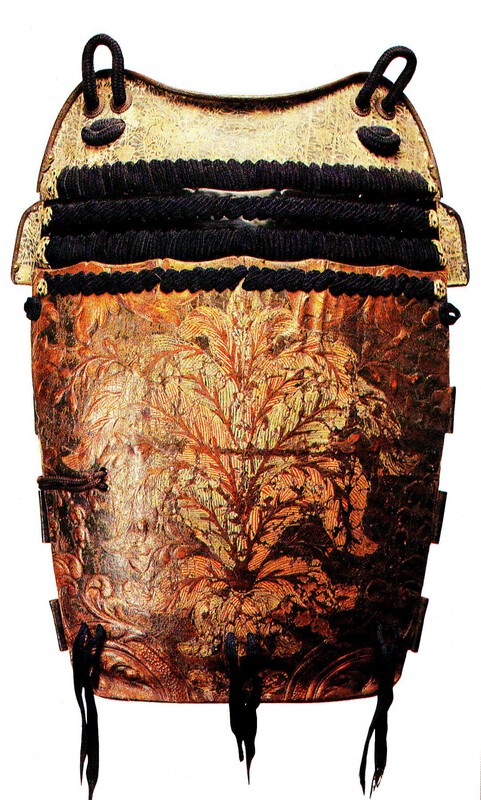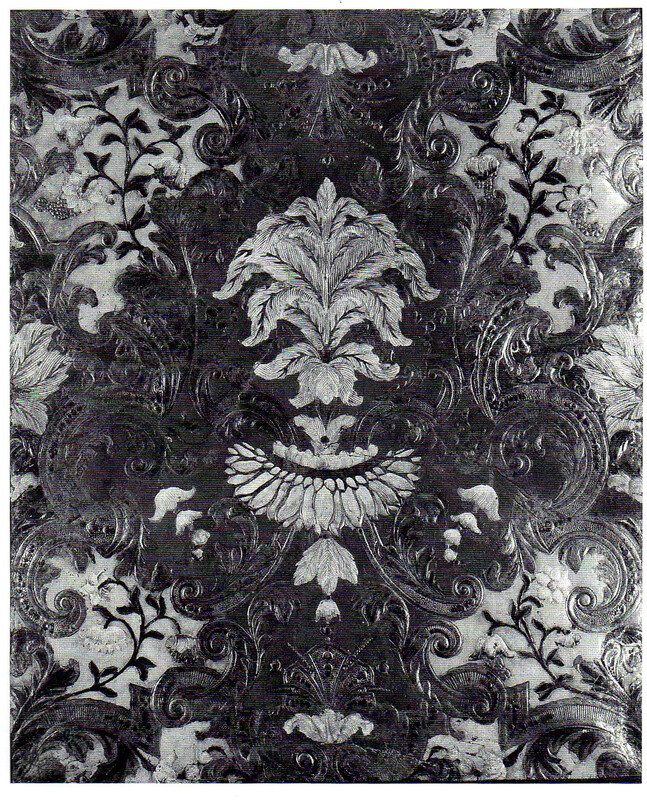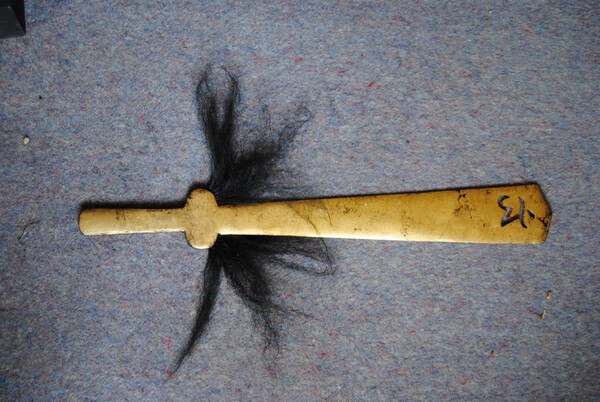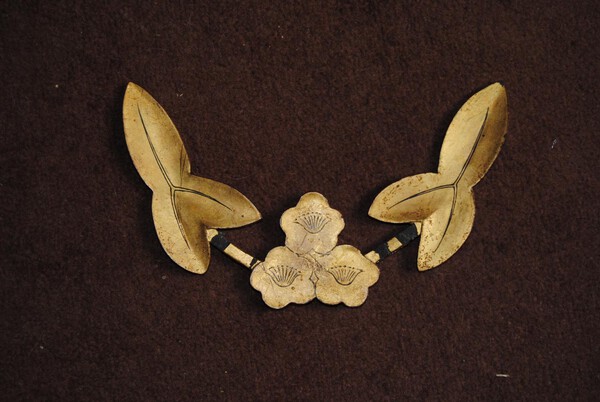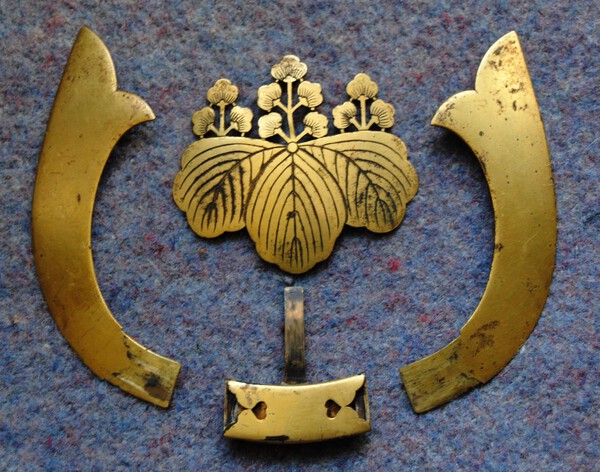
IanB
Members-
Posts
1,778 -
Joined
-
Last visited
-
Days Won
23
Content Type
Profiles
Forums
Events
Store
Downloads
Gallery
Everything posted by IanB
-
Ken, It would be good idea apart from the fact that so many helmets have had maedate added that had no association with each other. The answer may lie in in the battle screens that gave us answers as to what kamon many famous warriors used in the Sengoku Jidai. Thanks to the habit of applying labels identifying people appearing on these screens and noting what kamon the were using on their flags and other equipment we now know what heraldry some at least of these people used. I have a book on Seki ga hara which lists who was present and how many men they brought to the battle and it is surprising that we don't know what kamon some of the major players used. Ian Bottomley
-
Ford Hallam has had a heart attack and is hospitalized
IanB replied to Jean's topic in General Nihonto Related Discussion
Ford, Hang in there buddy we need you. Ian Bottomley -
I cannot see any way that this is original shokaku tsuki hachi. Such examples that have been recovered from tombs have been little more than iron oxide. Added to this is the fact that these excavated items are important museum items. I have seen one other more recent copy and like this I suspect it was made during the militaristic Taisho era to illustrate the martial history of the Japanese people. Ian Bottomley
-
Vajo, As you sew further towards the outer edge, keep pulling the thread so as to make the cloth pucker more and more and will then form the curved shape you need. When it is done it needs to fit into the helmet bowl leaving a space of about 2 or 3cm from the top of the lining to the inside top of the helmet bowl. You can then sew it temporarily into the helmet using the pairs of holes around the edge of the koshimaki and cut off the excess cloth. It pays to mark the edges of the cloth where it is sewn to the helmet to make sure it goes back properly later. Now take it off the helmet again and sew a strip of leather around the inside of the lining, about 2 - 3cm from the edge, the strip being wide enough to fold up and over the edge of the koshimaki. You can now sew the lining back into the helmet and fold the leather up and over the edge of the koshimaki, pasting or gluing the 1cm or so of leather to the outside of the koshimaki, This overlap will be hidden by the shikoro when it is fitted in place. For heavy helmets it was usual to fit two strips of leather above the lining, sewn to the koshimaki and crossing each other diagonally so to speak. These helped take the weight off the more fragile cloth. Ian Bottomley
-
Hideyoshi had an uma jirushi of a mass of golden gourds on wires, whilst Ieyasu had his giant golden fan. I had the privilege of handling the latter when we borrowed it for the Shogun exhibition in Leeds, and contrary to almost all the depictions of it, it doesn't have a red sun on and never had. What amused me was that there were profuse apologies that the bamboo pole it was carried on was now lost. Ian B
-
Chishiki, That is one of the best I have seen. I have a very simple one that sides on the saya. Imagine being without one and taking part in the daimyo gyoretsu, marching perhaps weeks or even months with a katana bashing on your hip bone. Ian Bottomley
-
Ignoring the toes - look at the tail. Lady dragons have a tail with a rounded end. Gentleman dragons quite naturally have a ken shaped sword attached. Ian Bottomley
-
Mark, I am reminded of a small accessory that all samurai would have but are very rare, and that is a small sleeve that fitted over the saya of the katana stopping it rubbing the saya of the wakizashi. I have one which is a simple tube made of rasha lined with silk that is shaped to fit around the kurigata region. Like the belts, minor items that nobody bothered about. I also have a few bad weather hilt covers that again were hardly every brought back by westerners in the 19th C. Ian B,
-
Mark, Looks a treat, as does the Kaga dou. I'm intrigued by the mail item hanging up. It looks like a mail covered belt worn under the yurugi ito of the armour. Did it come with it? I have one but mine has much more sparse mail. I wonder how often they were worn as you don't come across many. Ian Bottomley.
-
Folding fukigayeshi, normally only the right hand one, were fitted to helmets used by archers to prevent catching the bowstring. I have also seen a similar arrangement where about a quarter of the whole shikoro folded back for the same purpose. I suppose the same feature would have allowed a gunner to get his head in line with the sights of a teppo as well. Ian Bottomley
-
Malcolm, You have fallen into the same trap I did when I bought it. I assumed it was a ken, which the bonji implies as well. It isn't. It is the 'slap stick' used by Zen masters to hit those meditating. Ian
-
Piers, Your comments on eboshi are interesting in that I can understand the wearing of a fabric eboshi would imply status, but almost all eboshi nari kabuto are simply made of two plates, one each side, and I would say rather cheap. There is one in Liverpool museum which as a single plate forming one side, the other made up from 24 bits of iron riveted together. Dr. Galeno had a red lacquered Ii family tatami gusoku with tentsuki as a maedate and the Royal Armouries Museum has a red lacquered zunari kabuto that also has one. What is different about the zunari is that the brow plate / mabezashi is gold lacquered and it has a gessan shikoro laced in white, green and purple. Ian Bottomley
-
For The Armor Enthusiasts
IanB replied to Vermithrax16's topic in Auctions and Online Sales or Sellers
Fine armours, but the first at least has been somewhat restored. Note the use of jabara separating the two styles of stencilled leather rather than fusegumi sewing which armour two has. Also the leather, which is a suede deer skin, os just too clean and fresh. Invariably it gets more muted and grubby when dust gets into the porous surface. Ian Bottomley -
This Kaga go mai dou is interesting in having Dutch leather fastened to the front plate. It seems that Maeda Tsunanori, the fifth daimyo, following a visit to Kyoto, was so impressed by the refinement of the capital that he encouraged potters, lacquerers and metalworkers to come to Kanazawa and work for the Han. In 1637 he installed agents organised by a certain Hanawa Ichirobe, in Hirado and Nagasaki to purchase materials such as leather, woollen cloth, velvet, ivory and so forth from the Dutch and English. These materials were incorporated by the Haruta armourers then working in Kanazawa into their productions, hence the dou illustrated. You can imagine my surprise when walking around the Rijksmuseum in Amsterdam to see a wall covered in the same moulded, gilded and painted leather as my dou. I managed to meet the relevant curator who took me up into the attic and there in a storeroom he pulled out a sheet of the exact same leather, which the Dutch used for covering furniture, boxes and stretched on frames as a substitute for wood panelling on walls. Not only that but he also has the original the carved wooden mould that the leather on my armour had been made in. What a coincidence. Ian Bottomley
-
Here are a few examples. The omodaka one may be heraldic. The kuwagata plus kirimon in gilded copper is ridiculous. It belongs to an armour by Nagamichi and is only about 4" across yet it takes to pieces. The third one had me puzzled for a while. I will let you guess. Ian Bottomley
-
According to the research carried out by Orikasa Sensei amongst the Maeda papers in Kanezawa, only Haruta and independent armourers were employed in the Han until 1801 when the Myochin Muneyoshi was taken on. This dou seems to be by a Myochin Munetoshi whose real name was Sukekuro. He was granted a stipend for 3 people in 1826 and died in 1837. Interestingly this is one of the few Kaga armours that does not have the upper edges of the plates shaped. Ian Bottomley
-
ken, Probably just preference, but there is often an heraldic link. I have an unproven theory that the plain round gilded discs were put on by the armourers, to be exchanged for the customer's choice after the sale. Hosokawa Sansai is said to have advocated large delicate and easily damaged crests that looked 'romantic' after being broken. Some crests of kawari kabuto contribute to the theme of the helmet - such a ears on a helmet of animal shape. It is a good question I have never seen raised before. Ian Bottomley
-
Peter, One real give-away about sawasa is that the Japanese used shakudo as a base for decoration in gold whereas sawasa is the opposite with the shakudo used for the ornamentation on a gilt ground. Even more unusual is that the shakudo is generally black lacquered as well. Among the dozens of items in the Rijksmuseum publication are boxes with 'Japanese figures' as decoration that are distinctly NOT how the Japanese would depict themselves. Many of the others have rather poor depictions of pagodas, willow threes and other devices that appear to be cut out of sheet metal and fastened rather haphazardly on the gilt surface. We know that the Dutch were confined to Dejima in 1641 and that there was already a Chinese enclave in Nagasaki who were allowed to trade there. Whether the Chinese produced these items within the enclave, or ordered them from the Chinese mainland for sale to the Dutch I do not know. It seems that only the hilts and mounts of hangers and small swords were made there to be fitted to blades with typical German etching of the type done in Solingen elsewhere. This is consistent with the Japanese practice of searching the Dutch ships arriving at Dejima and confiscating all the weapons, returning them when they sailed away. The swords in the Rijksmuseum catalogue are dated as being from the last quarter of the 17th century to the second half of the 18th century.
-
Jan, I fully agree with you, but you must remember that there is very little information in the English, or indeed other European, language, available that details gun types. Perhaps more interesting are the small-swords with their 'shakudo' hilts. These fall into the class of material called sawasa which includes tobacco boxes, pipe cases an other objects. One item bears an ancient label describing t=it as having been obtained in Nagasaki and hence they are all assumed to be Japanese. Even a glance at the items illustrated in the book issued by the Rijksmuseum shows that they are in fact Chinese - probably made in the Chinese conclave there. Ian Bottomley
-
It is exactly to prevent the same creating bumps along the edges of the tsuka the tin wood shims are there. Remember there is no paper packing along the edges. Ian Bottomley
-
Steve, You asked the question as to how often do we know the names dates etc of crafts men, and I simply showed two examples where we do. The information was there in full when somebody took the trouble to look for it. In my own field Orikasa Sensei is one of few who seeks out information and perhaps more importantly considers his findings, argues its significance and publishes it. Nowhere did I deride useless speculation.. Yes I did quote the diary of a Bakamatsu armourer, but what I did not do is mention that the armourers working for the Maeda are fully documented back to the time of Maeda Toshiie (1538 - 1599) which is well within reach of Nobuie and his tsuba. . Ian
-
Steve, I'm afaid I must disagree to some extent with your argument. Some of the craftsmen working during the Edo period and earlier did leave considerably more details of their existence other than a name. Documents do exist is some cases and all it takes is for someone to take the trouble to search for and then publish them. I have in front of me a copy of a diary compiled by the famous armourer Myochin Muneyasu, admittedly a Bakamatsu smith, in which he lists the dates of commissions placed with his workshop, who placed them, what they ordered and what the cost was. He also lists the names of pupils who studied under his tuition, their original addresses, when they started their studies and how long they remained in his workshop. I happen to have an armour made by one of the pupils listed in that diary who declared that he had been a pupil of Myochin Muneyasu on various parts of the armour. Interestingly the diary states that in fact this tutor was in fact Myochin Munechika who seems to have be a junior partner in the workshop and was given the task of tutoring. Entirely separately, Orikasa Sensei took the trouble to study the surviving documents of the Maeda family in Kanazawa library. From these he compiled a complete list of the armourers who worked for the Han during the Edo period, their family relationships, their pupils, when the died and were superseded and who they trained as pupils. In some cases the papers list their stipends and their official position in the workshops. Many were members of the Haruta family, but others are listed as independents who given the coincidence of their dates probably did some of the routine work. Only rarely do we have any details of when they started work for the simple reason many were taken on as pupils and hence would only be performing mundane tasks for an indeterminate time. I accept that this sort of detail is unlikely to come to light with regard to most tsuba makers, but even the most humble would have been recorded somewhere at the time. This does not of course solve the problem of the chronology between workers who used the same name. The only resolution of this problem would be if someone, whose dates are known, wrote about an identifiable signed tsuba. Unlikely yes, but not impossible. Ian Bottomley
-
Ford, I am reminded that around this time there was, or was supposed to have been, a Myochin Nobuie, almost certainly a different person from the tsuba maker and judging by some of his supposedly early signatures, probably a later fabrication. In the case of the armourer, there is a distinct lack of proof of age, despite the fact that quite a few helmet are dated. What is telling I think is that every one of these helmets is now incorporated into an Edo period armour and nothing signed any Myochin occurs in any Sengoku era armour. Unlike tsuba, helmet bowls couldn't be swapped and changed readily so I think we can say with confidence that these dated helmets are definitely spurious. We know that Myochin Munesuke wrote a fictitious genealogy in the 17th century simply for the 'new boys on the block' to get commissions.from officialdom. By chance I am working on a diary of various Myochin Bakamatsu smiths in which Munechika states he repaired a Nobuie helmet dated Tenmon 3rd year (1534). Clearly he believed it was genuine and presumably so did the owner who paid over 19 ryo for the repair. Ian bottomley
-
It maybe that I have a wakizashi with the matching fuchi / gashira, but it does not have a slot for a kozuka. Ian Bottomley.
-
All, I have always been fascinating by kamon and have a good selection of books on the subject, the majority of which do not attribute them to families for the simple reason that, unlike European heraldry which was regulated by the heralds, there was no official regulation of them. The only book I have managed to acquire is Seishi Kamon no Jiten which lists modern family names and the kamon they use. Ian Bottomley


